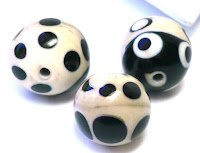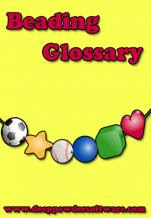 Reflecting on my efforts to date it’s clear that there is more than one way to be dotty. You can dot in specific spots, cover a bead in dots, scatter them, fleck them or litter them. The dot might be a speck, a circle or a strange dab on the surface of the bead. They might be symmetrical or not. You can pair dots, line them up, angle them or squash them. So, as you can see a dot is not just a dot. There is a glorious range of dotty possibilities.
Reflecting on my efforts to date it’s clear that there is more than one way to be dotty. You can dot in specific spots, cover a bead in dots, scatter them, fleck them or litter them. The dot might be a speck, a circle or a strange dab on the surface of the bead. They might be symmetrical or not. You can pair dots, line them up, angle them or squash them. So, as you can see a dot is not just a dot. There is a glorious range of dotty possibilities. In my efforts to become a better dotty beader and explore those possibilities I’m gathering a dotty technique a day using my old friend Google. Today’s dotty technique comes from: Glass Beads: Tips, Tools, and Techniques for Learning the Craft, By Louise Mehaffey, Kevin (PHT) Brett. Lousie show how dots can be flattened with a paddle to add a decorative effect or to increase their footprint. You can then also poke the dot to add a decorative effect (see page 60).
Decorative dotty possibilities are not new to beaders. They have been using dots to decorate glass beads across the centuries.. The Solarflare Creations website (http://www.solarflarecreations.com.au/Timeline.htm) has a fascinating overview of the history of dotty decorations on beads that includes images of dotted Celtic beads from France and England (350 – 100 BC), Chinese Warring States beads (480-220BC) and Compound Eye Beads from the Mediterranean Basin (400-300 BC).

In current times, contemporary beader Deanna Griffin Dove has even devoted a book to dots.
Dot, Dot, Dots! ISBN # 978-0-9789721-1-0
For a beginning beady dotter, such as myself, the possibilities seem overwhelmingly and gloriously endless. With only my imagination to limit what might happen my desire to be a dotty beader could be with me for a while.
If you have dotty beads in your life – wearing them, designing with them or making them I’d love to hear about the dots in your life.




















































